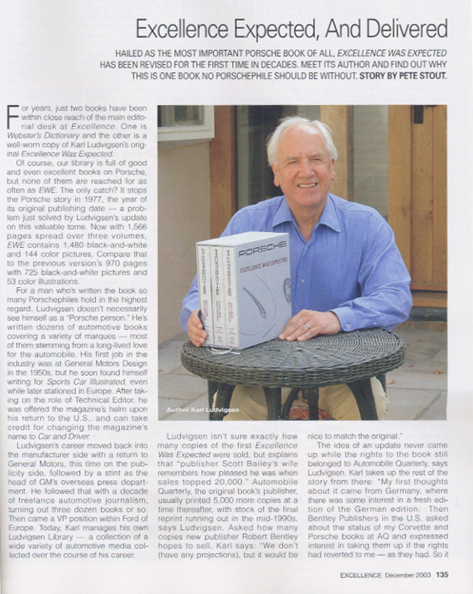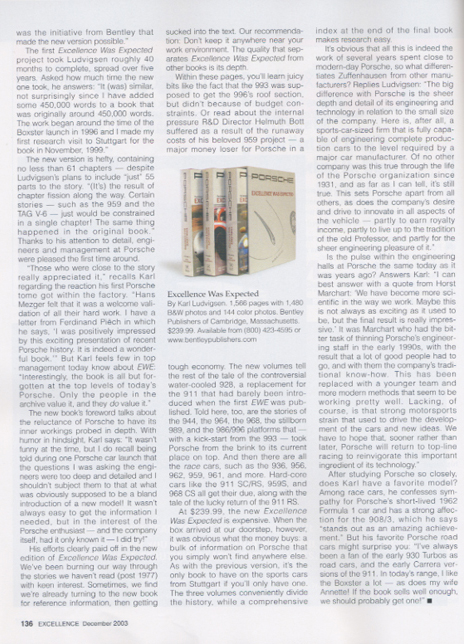|
Porsche: Excellence Was Expected
Price: $629.95
|

excellence - December 2003
Excellence Expected, And Delivered
HAILED AS THE MOST IMPORTANT PORSCHE BOOK OF ALL, EXCELLENCE WAS EXPECTED HAS BEEN REVISED FOR THE FIRST TIME IN DECADES. MEET ITS AUTHOR AND FIND OUT WHY THIS IS ONE BOOK NO PORSCHEPHILE SHOULD BE WITHOUT.
STORY BY PETE STOUT.
For years, just two books have been within close reach of the main editorial desk at Excellence. One is Webster's Dictionary and the other is a well-worn copy of Karl Ludvigsen's original Excellence Was Expected.
Of course, our library is full of good and even excellent books on Porsche, but none of them are reached for as often as EWE. The only catch? It stops the Porsche story in 1977, the year of its original publishing date ? a problem just solved by Ludvigsen's update on this valuable tome. Now with 1,566 pages spread over three volumes, EWE contains 1,480 black-and-white and 144 color pictures. Compare that to the previous version's 970 pages with 725 black-and-white pictures and 53 color illustrations.
For a man who's written the book so many Porschephiles hold in the highest regard, Ludvigsen doesn't necessarily see himself as a "Porsche person." He's written dozens of automotive books covering a variety of marques ? most of them stemming from a long-lived love for the automobile. His first job in the industry was at General Motors Design in the 1950s, but he soon found himself writing for Sports Car Illustrated, even while later stationed in Europe. After taking on the role of Technical Editor, he was offered the magazine's helm upon his return to the U.S., and can take credit for changing the magazine's name to Car and Driver.
Ludvigsen's career moved back into the manufacturer side with a return to General Motors, this time on the publicity side, followed by a stint as the head of GM's overseas press department. He followed that with a decade of freelance automotive journalism, turning out three dozen books or so. Then came a VP position within Ford of Europe. Today, Karl manages his own Ludvigsen Library ? a collection of a wide variety of automotive media collected over the course of his career.
Ludvigsen isn't sure exactly how many copies of the first Excellence Was Expected were sold, but explains that "publisher Scott Bailey's wife remembers how pleased he was when sales topped 20,000." Automobile Quarterly, the original book's publisher, usually printed 5,000 more copies at a time thereafter, with stock of the final reprint running out in the mid-1990s, says Ludvigsen. Asked how many copies new publisher Robert Bentley hopes to sell, Karl says: "We don't (have any projections), but it would be nice to match the original."
The idea of an update never came up while the rights to the book still belonged to Automobile Quarterly, says Ludvigsen. Karl takes up the rest of the story from there: "My first thoughts about it came from Germany, where there was some interest in a fresh edition of the German edition. Then Bentley Publishers in the U.S. asked about the status of my Corvette and Porsche books at AQ and expressed interest in taking them up if the rights had reverted to me ? as they had. So it was the initiative from Bentley that made the new version possible."
The first Excellence Was Expected project took Ludvigsen roughly 40 months to complete, spread over five years. Asked how much time the new one took, he answers: "It (was) similar, not surprisingly since I have added some 450,000 words to a book that was originally around 450,000 words. The work began around the time of the Boxster launch in 1996 and I made my first research visit to Stuttgart for the book in November, 1999." The new version is hefty, containing no less than 61 chapters ? despite Ludvigsen's plans to include "just" 55 parts to the story. "(It's) the result of chapter fission along the way. Certain stories ? such as the 959 and the TAG V-6 ? just would be constrained in a single chapter! The same thing happened in the original book." Thanks to his attention to detail, engineers and management at Porsche were pleased the first time around.
"Those who were close to the story really appreciated it," recalls Karl regarding the reaction his first Porsche tome got within the factory. "Hans Mezger felt that it was a welcome validation of all their hard work. I have a letter from Ferdinand Piech in which he says, 'I was positively impressed by this exciting presentation of recent Porsche history. it is indeed a wonderful book.'" But Karl feels few in top management today know about EWE: "Interestingly, the book is all but forgotten at the top levels of today's Porsche. Only the people in the archive value it, and they do value it."
The new book's foreword talks about the reluctance of Porsche to have its inner workings probed in depth. With humor in hindsight, Karl says: "It wasn't funny at the time, but I do recall being told during one Porsche car launch that the questions I was asking the engineers were too deep and detailed and I shouldn't subject them to that at what was obviously supposed to be a bland introduction of a new model! It wasn't always easy to get the information I needed, but in the interest of the Porsche enthusiast ? and the company itself, had it only known it ? I did try!"
His efforts clearly paid off in the new edition of Excellence Was Expected. We've been burning our way through the stories we haven't read (post 1977) with keen interest. Sometimes, we find we're already turning to the new book for reference information, then getting sucked into the text. Our recommendation: Don't keep it anywhere near your work environment. The quality that separates Excellence Was Expected from other books is its depth.
Within these pages, you'll learn juicy bits like the fact that the 993 was supposed to get the 996's roof section, but didn't because of budget constraints. Or read about the internal pressure R&D Director Helmuth Bott suffered as a result of the runaway costs of his beloved 959 project ? a major money loser for Porsche in a tough economy. The new volumes tell the rest of the tale of the controversial water-cooled 928, a replacement for the 911 that had barely been introduced when the first EWE was published. Told here, too, are the stories of the 944, the 964, the 968, the stillborn 989, and the 986/996 platforms that ? with a kick-start from the 993 ? took Porsche from the brink to its current place on top. And then there are all the race cars, such as the 936, 956, 962, 959, 961, and more. Hard-core cars like the 911 SC/RS, 959S, and 968 CS all get their due, along with the tale of the lucky return of the 911 RS.
At $239.99, the new Excellence Was Expected is expensive. When the box arrived at our doorstep, however, it was obvious what the money buys: a bulk of information on Porsche that you simply won't find anywhere else. As with the previous version, it's the only book to have on the sports cars from Stuttgart if you'll only have one. The three volumes conveniently divide the history, while a comprehensive index at the end of the final book makes research easy.
It's obvious that all this is indeed the work of several years spent close to modern-day Porsche, so what differentiates Zuffenhausen from other manufacturers? Replies Ludvigsen: "The big difference with Porsche is the sheer depth and detail of its engineering and technology in relation to the small size of the company. Here is, after all, a sports-car-sized firm that is fully capable of engineering complete production cars to the level required by a major car manufacturer. Of no other company was this true through the life of the Porsche organization since 1931, and as far as I can tell, it's still true. This sets Porsche apart from all others, as does the company's desire and drive to innovate in all aspects of the vehicle - partly to earn royalty income, partly to live up to the tradition of the old Professor, and partly for the sheer engineering pleasure of it."
Is the pulse within the engineering halls at Porsche the same today as it was years ago? Answers Karl: "I can best answer with a quote from Horst Marchart: 'We have become more scientific in the way we work. Maybe this is not always as exciting as it used to be, but the final result is really impressive.' It was Marchart who had the bitter task of thinning Porsche's engineering staff in the early 1990s, with the result that a lot of good people had to go, and with them the company's traditional know-how. This has been replaced with a younger team and more modern methods that seem to be working pretty well. Lacking, of course, is that strong motorsports strain that used to drive the development of the cars and new ideas. We have to hope that, sooner rather than later, Porsche will return to top-line racing to reinvigorate this important ingredient of its technology."
After studying Porsche so closely, does Karl have a favorite model? Among race cars, he confesses sympathy for Porsche's short-lived 1962 Formula 1 car and has a strong affection for the 908/3, which he says "stands out as an amazing achieve ment." But his favorite Porsche road cars might surprise you: "I've always been a fan of the early 930 Turbos as road cars, and the early Carrera ver sions of the 911. In today's range, I like the Boxster a lot ? as does my wife Annette! If the book sells well enough, we should probably get one!"
Excellence Was Expected
By Karl Ludvigsen. 1,566 pages with 1,480 B&W photos and 144 color photos. Bentley Publishers of Cambridge, Massachusetts. $239.95. Available from (800) 423-4595 or www.bentleypublishers.com

Author Karl Ludvigsen

![[B] Bentley Publishers](http://assets1.bentleypublishers.com/images/bentley-logos/bp-banner-234x60-bookblue.jpg)

